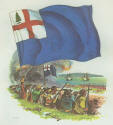 Bunker
Hill Flag
Bunker
Hill FlagDate: June 17, 1775
Blue field. Canton, red cross of St. George, small pine tree in upper left corner of canton. (R11)
There is debate on the exact colors of the American ensign flying at the Battle of Bunker Hill in 1775. So accounts report a red field instead of blue. Other reports claim that both banners were used. The British displayed both, the British Red Ensign and the Blue Ensign.
In Boston, a big pine tree stood at the corner of what is now Essex and Washington streets. The minutemen met beneath its shade. It became the Liberty Tree on which they hanged the effigy of Oliver, the British stamp tax distributor.
So while the New England colonies expressed their loyalty to the Mother country by using the cross of St. George on their flag, they asserted their right to place on the same banner the pine tree that Massachusetts stamped on its coins.
 The
Battles of Lexington and Concord had been fought by Massachusetts alone.
But by July, 1775, a good-sized army of those who had fought at
Bunker-Breed's Hill as well as militia from all the thirteen colonies
were camped at Cambridge.
The
Battles of Lexington and Concord had been fought by Massachusetts alone.
But by July, 1775, a good-sized army of those who had fought at
Bunker-Breed's Hill as well as militia from all the thirteen colonies
were camped at Cambridge.
The Battle of Bunker Hill took place on Breed's Hill near Boston on the Charlestown Peninsula. The inexperienced New England army entrenched itself by mistake on the night of June 16th, 1775. There was no plan for reinforcement and there were no munitions in reserve.
The peninsula they defended could have been cut off by a few British troops, but the British were intent on a frontal assault. The British succeeded in routing the Americans on the third assault, but only after suffering extreme losses.